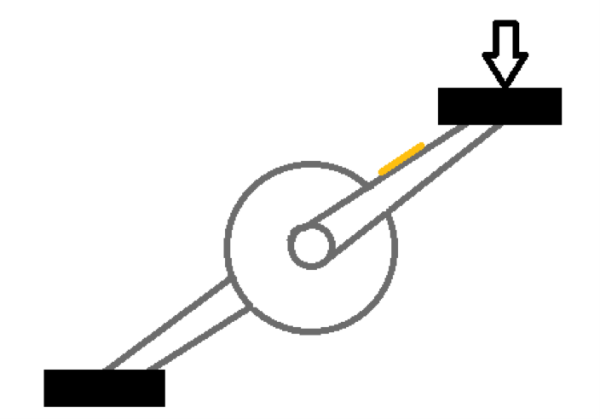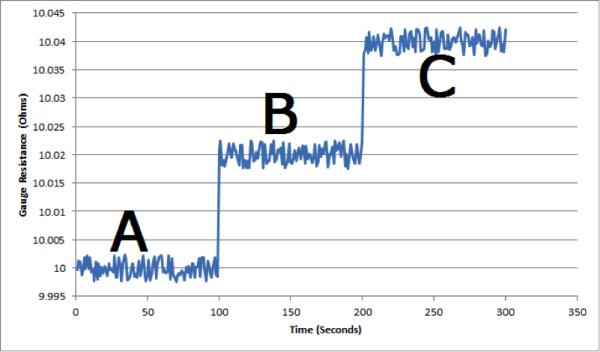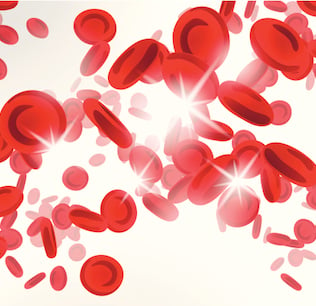“Relative” vs "Absolute" Muscle Oxygenation Measurement: What’s the Difference?
One of the differentiating factors between Moxy and many of the other Near Infrared Spectroscopy (NIRS) devices on the market (both athletic and medical markets) is that Moxy measures SmO2 on an absolute scale from 0% to 100%. Many other devices can provide an indication of whether oxygenation goes up or down, but they provide no information about where the oxygenation is on the range between fully saturated and fully desaturated.
Relative vs Absolute Measurement
The notion of an absolute versus a relative measurement can be a little bit challenging to get your head around. Consider a simplified example of a strain gauge to measure crank torque. A strain gauge is a long fine wire. When the wire is stretched within its elastic range, it gets longer and the diameter gets smaller just like a rubber band. This makes the electrical resistance of the wire increase slightly which can be measured with sensitive electronics to measure strain and therefore torque.

Now consider a strain gauge that is mounted on a crank arm or some other component of the cycling power train such that when the rider applies force to the pedals, the material under the strain gauge is in tension. This causes the electrical resistance of the gauge to increase with increasing torque.

If someone were to give us only the resistance data from a static load test and no other calibration information, that would be an example of a relative measurement of torque. We don’t know what resistance of the gauge is at 0 torque and we don’t know how much the resistance increases when more torque is applied. We DO know that when torque goes up, resistance goes up. We are missing the Zero and the Slope for the calibration curve.
The following graph shows what some resistance data might look like.

Even though we don’t know the Zero or the Slope there are still some conclusions we can make based on the fact that we know the strain gauge is in tension:
- The torque was relatively steady during each of the A, B, and C segments of time.
- The torque during the B segment was higher than the A segment.
- The torque during the C segment was higher than the A and B segments.
Also, notice some conclusions that we can NOT make:
- We don’t know the actual torque during any segment.
- We don’t know if B is a little higher than A or a lot higher than A.
Besides Zero and Offset, there is a third calibration parameter that affects the conclusions we can draw, and it is called Linearity. Strain gauges have a pretty nice linear relationship between strain and resistance. Since we know that, there is another conclusion that we can draw:
- The difference in torque between C and B is about the same as the difference in torque between B and A.
However, if we didn’t know the system was linear, it could be possible that B torque is a lot bigger than A, but that the C torque is only a little bigger than B.
Relative vs Absolute Measurement and Muscle Oxygenation
Let’s bring this back to muscle oxygenation measurements. As I noted earlier, muscle oxygenation is measured by a technique called Near Infrared Spectroscopy (NIRS). With NIRS, multiple different colors of light are emitted into the tissue, and the light that has been scattered some distance through the tissue is measured with some type of photodetector. The resulting raw data is the intensity of each color of light that makes it to the photodetector. The intensity of each color depends on the muscle oxygenation plus a host of unwanted factors like the light source intensity, skin color, fat thickness, water content and others. The NIRS measurement device uses some type of algorithm to produce an output with minimized sensitivity to the unwanted factors and maximized sensitivity to muscle oxygenation.
Some NIRS devices measure oxygenation in a relative sense like our hypothetical strain gauge above. Other devices measure oxygenation in an absolute sense, which would be like our strain gauge example where you know the Zero, Slope, and Linearity. The absolute algorithms allow the user to draw more conclusions about the physiology of the athlete.
To be precise, it’s really a sliding scale between absolute and relative. All measurement devices have some sources of error. The Zero might drift, the Slope might be sensitive to temperature, the Linearity isn’t perfect, etc. However, when the errors are small enough to provide useful conclusions based on the magnitude of the oxygenation on a consistent basis, we say that the measurement is absolute. When the uncertainty on the Zero, Slope, and Linearity are large relative to the measurement being taken, we say that the measurement is relative.
Going back to our strain gauge example, there are some common features that we can look for to identify how a power meter manufacturer accomplishes absolute measurement. For example, this post from DC Rainmaker describes how the 4iiii Precision power meter is calibrated by the user after it is installed. An S-hook load cell is used to apply a known load to the crank arm which is used to determine an accurate Slope. The unit also does a zero offset before each ride like many other power meters to get an accurate Zero. The review also talks about temperature compensation for the device. The strain gauge resistance changes with temperature, which is an unwanted sensitivity. The device has an algorithm to minimize this. Without these features, 4iiii would have a power meter that operates much more on the relative end of the spectrum. When we understand these features, we can understand how 4iiii makes an accurate power meter that reads on an Absolute scale.
NIRS: Calibrating for Absolute Measurement
There are also features on a NIRS device that provide clues about whether the device is more on the absolute end or relative end of the spectrum. The features I typically look for are:
- Light intensity control
- Color control
- Unwanted sensitivity to skin blood flow, fat and melanin
- How the unit is calibrated
To make sense of the intensity readings that come out of the tissue, you need to have some idea of how much light went in to the tissue. The light sources typically used for NIRS devices are not nearly stable enough to simply measure how bright they are at the factory and assume they stay that way. There are two common ways to deal with this problem. One is to have an internal detector that measures the light intensity directly, and the other is to detect light that has taken different path lengths through the tissue.
Typical NIRS light sources also are not stable enough in their color to take absolute oxygenation readings. Sometimes this is accommodated with optics, but that is very expensive. There are various clever techniques that allow the color changes to be monitored and corrected by the algorithm which are must less costly from a hardware perspective.
The unwanted sensitivity to skin, blood, fat, and melanin is never perfectly accommodated, but some devices can make the effects small enough so the measurements are effectively absolute. Typically, devices with greater amounts of different colors and light-emitter-to-light-detector spacings have the most information to work with to minimize unwanted sensitivities. However, a clever selection of which colors and which spacings to use is also important, so more isn’t always better.
There is no “Gold Standard” device to measure muscle oxygenation, so calibration is not as simple as making your device read the same as the Gold Standard device. There are three common approaches to this problem.
One is to build some type of a tissue phantom where blood can be circulated through at controlled oxygenation levels. The problem with phantoms is that it is not possible to match the optical properties of human tissue precisely and it is not usually practical to make phantoms that cover all of the ranges of properties where the device is expected to be used.
Another approach is to calibrate on humans. This requires doing some type of a blood draw so the actual oxygenation can be measured. The problem here is that the blood can’t be drawn directly from the capillaries, and it is not practical to cover the entire range of optical conditions where the device is expected to work.
A third approach is to use a mathematical model of how light propagates through tissue that includes the optical properties of each of the desired and undesired sensitivities. This allows a very large range of optical conditions to be modeled, but the drawback is that this approach is very computationally intensive.
The Moxy Sensor was designed specifically to address the need for these NIRS features. Moxy uses the multiple light path solution to deal with the light intensity issue. It employs a combination of a temperature sensor and a rigorous color calibration at the factory level to deal with the color stability issues.
The unique feature of Moxy is that it utilizes a complex mathematical model to accommodate both the unwanted sensitivities and the calibration issue. Parts of the model are run only one time and the data is used for all Sensors; parts of the model are run at the factory for each Sensor and are based on its precise color stability. The final part of the model is run on the Sensor so it can read muscle oxygenation on an absolute scale in real time. This allows most of the computationally intensive work to be done ahead of time at the factory. However, it still requires a more sophisticated processor in the Sensor than a relative algorithm would require.
More Information with Absolute Measurement
In the hypothetical strain gauge torque sensor example above, we saw that some information was available with a relative sensor but that more was available with an absolute sensor. The same is true for muscle oxygenation sensors.
Relative sensors are good for providing information on when certain events occur. A common application of this is looking for the muscle oxygen break point in a graded exercise test as an indication of some type of lactate threshold. This paper shows the relationship. If the test conditions are well controlled, the muscle oxygenation will often stay stable as the load is increased up to a point. When the load is increased further, the muscle oxygenation will drop. A relative algorithm provides sufficient information to identify this trend.
Another example of a relative algorithm providing useful information would be to identify when an athlete has recovered to their baseline SmO2 reading. Some type of warm-up protocol can be performed to establish the baseline. The athlete could perform a drill and then the time could be measured from the end of the drill until the muscle oxygen level returns to baseline.
A clever way to work around the limitations of a relative muscle oxygen sensor is elaborated on in this paper. The method uses a mechanical occlusion to completely block blood flow to an extremity to induce 0% oxygenation as a means to partially calibrate the system in that given set of conditions. With this method, the magnitude of the changes in oxygenation can be used to quantify mitochondrial function. However, this method has some significant practical limitations in non-research settings.
The findings of the paper underscore an important point: when you want to know information on the magnitude of changes in oxygenation you need to have some type of absolute measurement of oxygenation. The example above of quantifying the oxidative capacity of mitochondria is one such case, but there are many others.
Another example that illustrates this can be found when looking at how far an athlete is able to deoxygenate a muscle during a certain type of exercise. In many cases, the athlete will deoxygenate to some extent. However, in certain cases where oxygen utilization capacity exceeds the delivery capacity, the athlete will deoxygenate further. Athletes whose performance is limited by their oxygen utilization capacity will not deoxygenate nearly as far.
Absolute measurements are also required when you want to compare the relationship of specific data:
- From one day to the next
- From one muscle to another
- From the left to right side
- From one athlete to another
Absolute muscle oxygenation measurement can help answer targeted questions like:
- How has my training changed my ability to deliver or utilize oxygen?
- I see drops in both the calf and the quadriceps under load. Which is larger?
- Are my legs physiologically balanced?
- As an athlete, does the way in which I breathe allow me to recover to a higher oxygenation level?
Conclusion
With the development of absolute muscle oxygenation measurement capability in a sensor that is designed for athletic environments, NIRS technology has reached a level where muscle oxygenation can be used as a training metric in its own right. There is no longer a need to devise specific workout protocols that induce a correlation between a change in NIRS data and some other physiological event.
Absolute muscle oxygenation data is useful by itself because it allows information about muscle metabolism to be interpreted in real time. Athletes and trainers can watch the data as it happens while the athlete is performing their sport. The science on using this information for guiding athletic training is just beginning to emerge. The possibilities are truly exciting.


